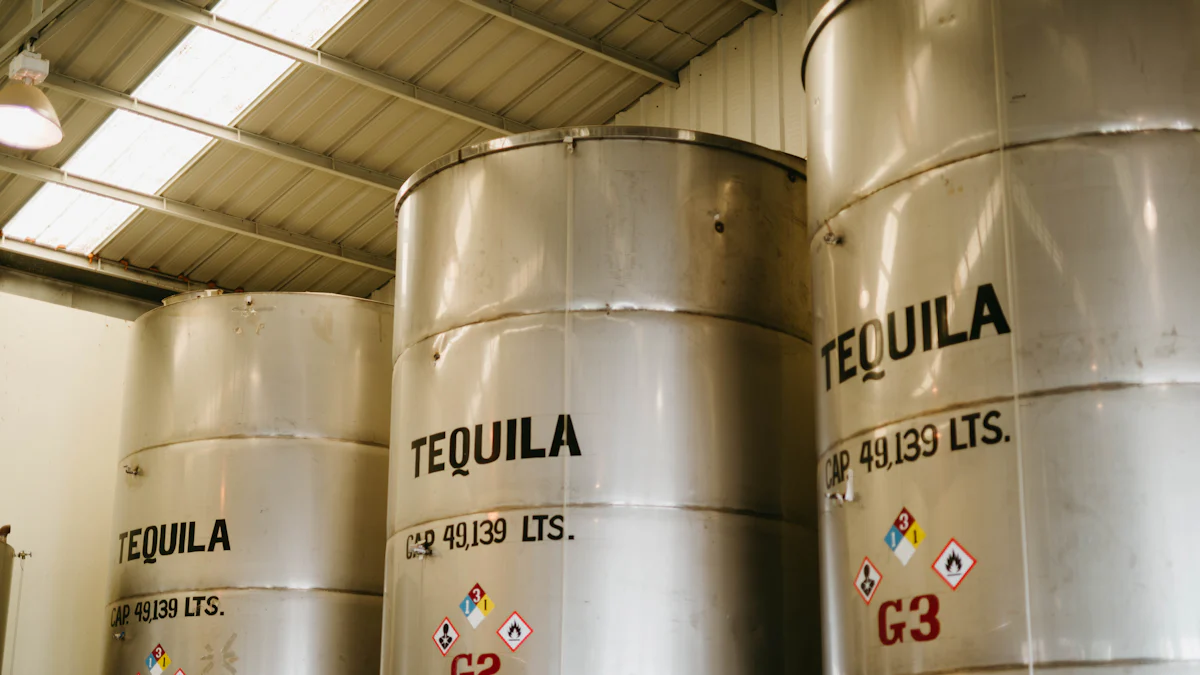
The density of aluminum stands at approximately 2.7 g/cm³, making it one of the lightest metals used in engineering. In contrast, steel exhibits a density ranging from 7.75 to 8.0 g/cm³, nearly three times that of aluminum. Tungsten, with its remarkable density of 19.3 g/cm³, surpasses both by a significant margin. These differences in density influence material selection across industries. Aluminum’s lightweight nature offers advantages in weight-sensitive applications, while steel and tungsten provide superior strength and durability due to their higher densities.
Key Takeaways
- Aluminum’s low density (2.7 g/cm³) makes it ideal for weight-sensitive applications, particularly in aerospace, where reducing weight enhances fuel efficiency.
- Steel’s higher density (7.75-8.0 g/cm³) provides the strength necessary for load-bearing structures, making it essential in construction and heavy machinery.
- Tungsten, with an extraordinary density of 19.3 g/cm³, excels in applications requiring extreme durability and resistance to wear, such as military-grade equipment.
- Understanding the density of materials helps engineers make informed decisions, balancing weight, strength, and cost for optimal performance in their projects.
- In the automotive industry, a combination of aluminum and steel is used to enhance vehicle performance by reducing weight while ensuring safety and durability.
- Density analysis is crucial in material science, allowing for the identification and characterization of materials based on their unique density values.
- Choosing the right material based on density can lead to significant cost savings in manufacturing and transportation, as lighter materials are often easier to handle.
Understanding the Density of Aluminum and Other Materials
What Is Density?
For example, the density of aluminum is approximately 2.7 g/cm³, which means a cubic centimeter of aluminum weighs 2.7 grams.
Density plays a critical role in material science. It allows researchers to analyze the structure and composition of materials. For instance, scientists use density analysis to distinguish between materials that may appear similar but have different internal compositions. This method is particularly useful in industries like aerospace and automotive, where precision and material performance are paramount.
“Density analysis aids in identifying and characterizing materials based on their unique density values.” – Material Characterization through Density Analysis
Understanding density also helps in predicting how a material will behave under specific conditions. A denser material often exhibits greater strength and durability, while a less dense material may offer advantages in weight-sensitive applications. This balance between density and performance is why engineers carefully evaluate density when selecting materials for projects.
Why Density Matters in Material Selection
Density is more than just a number; it directly influences how a material performs in real-world applications. When I consider the density of aluminum, I see its lightweight nature as a key advantage. This property makes aluminum ideal for industries like aerospace, where reducing weight can improve fuel efficiency and overall performance. On the other hand, steel’s higher density provides the strength needed for construction and heavy machinery.
Material selection often involves balancing weight, strength, and cost. For example:
- Aerospace Industry: Lightweight materials like aluminum reduce the overall weight of aircraft, improving fuel efficiency and payload capacity.
Density ensures structural integrity in buildings and bridges, making it a preferred choice for load-bearing applications. - Automotive Industry: Engineers use a combination of aluminum and steel to optimize vehicle performance, balancing weight reduction with safety and durability.
Density also affects how materials interact with external forces. A denser material like tungsten, with its 19.3 g/cm³ density, offers exceptional resistance to deformation and wear. This makes it suitable for applications requiring extreme toughness, such as military-grade equipment or high-performance tools.
“Understanding the density of different metals allows engineers and designers to select the appropriate material for their specific needs.” – Metals Density Influence on Engineering Decisions
Density Comparison: Aluminum vs Steel vs Tungsten

Numerical Comparison
When I compare the densities of aluminum, steel, and tungsten, the differences become striking. Aluminum has a density of approximately 2.7 g/cm³, making it one of the lightest engineering metals. Steel, on the other hand, ranges from 7.75 to 8.0 g/cm³, which is nearly three times denser than aluminum. Tungsten surpasses both with an extraordinary density of about 19.3 g/cm³, placing it among the densest metals available.
To put these numbers into perspective:
- Aluminum: 2.7 g/cm³
- Steel: 7.75–8.0 g/cm³
- Tungsten: 19.3 g/cm³
This comparison highlights how aluminum’s lightweight nature contrasts sharply with the heavier steel and tungsten. For example, a cubic centimeter of tungsten weighs over seven times more than the same volume of aluminum. These numerical differences directly influence how each material performs in various applications.
“The density of a material determines its weight for a given volume, which is critical in engineering and design.” – Fundamentals of Material Science
Implications of Density Differences
The density of aluminum, steel, and tungsten affects their suitability for specific uses. Aluminum’s low density makes it ideal for applications where weight reduction is crucial. In aerospace engineering, for instance, lighter materials improve fuel efficiency and payload capacity. Steel, with its moderate density, offers a balance of strength and weight, making it indispensable in construction and automotive industries. Tungsten, due to its extreme density, excels in specialized applications requiring exceptional toughness and resistance to wear.
Here’s how these density differences translate into real-world implications:
- Weight-Sensitive Applications: Aluminum dominates industries like aerospace and transportation. Its lightweight nature reduces energy consumption and enhances performance.
- Structural Integrity: Steel’s higher density provides the strength needed for load-bearing structures, such as bridges and skyscrapers.
- Extreme Durability: Tungsten’s density ensures unmatched resistance to deformation, making it suitable for military-grade equipment and high-performance tools.
Each material’s density also influences cost and manufacturing processes. Aluminum, being lightweight, is easier to transport and shape, reducing production costs. Steel, while heavier, remains cost-effective due to its widespread availability and versatility. Tungsten, though expensive, justifies its cost in applications where no other material can match its performance.
Understanding these implications helps me appreciate why engineers prioritize density when selecting materials. The right choice depends on the specific demands of the project, whether it’s minimizing weight, maximizing strength, or achieving unparalleled durability.
Impact of Density on Applications

Construction Industry
In construction, material density directly affects structural integrity and overall project efficiency. I often see steel as the go-to material for load-bearing structures like bridges and skyscrapers. Its density, ranging from 7.75 to 8.0 g/cm³, provides the strength needed to support immense weight and withstand environmental stresses. For example, maraging steel, with its high density and toughness, is frequently used in specialized construction projects requiring exceptional durability.
Aluminum, with its lower density of 2.7 g/cm³, plays a different role in construction. Its lightweight nature makes it ideal for non-load-bearing components, such as window frames, roofing, and decorative elements. Aluminum reduces the overall weight of structures, simplifying transportation and installation. This property also lowers labor costs and accelerates project timelines.
“Solid density measurements are crucial for assessing the strength and processability of building materials.” – Solid Density of Building Materials and Its Importance
The choice between aluminum and steel depends on the specific demands of the project. Steel dominates where strength is paramount, while aluminum excels in applications requiring lightweight and corrosion-resistant materials.
Automotive Industry
In the automotive industry, density influences vehicle performance, fuel efficiency, and safety. Engineers often use a combination of aluminum and steel to optimize these factors. Steel, with its higher density, provides the strength needed for critical components like the chassis and suspension systems. These parts must endure significant stress and impact, making steel indispensable for ensuring passenger safety.
Aluminum, on the other hand, contributes to weight reduction. Its low density improves fuel efficiency by reducing the overall mass of vehicles. For instance, many modern cars feature aluminum hoods, doors, and engine blocks. These components not only enhance performance but also lower emissions, aligning with environmental regulations.
“Comparing materials based on strength-to-weight ratio is crucial for weight optimization.” – Optimizing Weight through Material Selection
The balance between aluminum and steel allows automakers to create vehicles that are both lightweight and robust. This combination ensures a safer, more efficient driving experience.
Aerospace Industry
In aerospace engineering, the density of materials plays a pivotal role in design and functionality. Aluminum, with its lightweight properties, is a cornerstone of this industry. Its density of 2.7 g/cm³ makes it ideal for aircraft frames, wings, and fuselages. By reducing the weight of these components, aluminum improves fuel efficiency and increases payload capacity. This advantage is critical in an industry where every gram counts.
Steel, despite its higher density, finds use in aerospace applications requiring exceptional strength. For example, maraging steel, with its density of around 8.0 g/cm³, is often used in landing gear and other high-stress components. These parts must endure extreme forces during takeoff and landing, making steel’s strength indispensable.
Tungsten, with its extraordinary density of 19.3 g/cm³, serves specialized purposes in aerospace. It is commonly used in counterweights, radiation shielding, and high-performance tools. Tungsten’s density ensures unmatched durability and resistance to wear, even under the most demanding conditions.
“Understanding metal density is crucial for designing various structures and improving project efficiency.” – Influence of Metal Density on Engineering Decisions
The aerospace industry exemplifies how density impacts material selection. Aluminum dominates weight-sensitive applications, while steel and tungsten provide the strength and durability needed for critical components.
Advantages and Limitations of Aluminum, Steel, and Tungsten
Aluminum
Aluminum stands out as a lightweight yet durable metal. Its density of 2.7 g/cm³ makes it ideal for applications where weight reduction is critical. I often see aluminum used in aerospace, automotive, and construction industries due to its excellent strength-to-weight ratio. This property allows engineers to design structures that are both strong and lightweight. For example, in modern vehicles, aluminum components like hoods and engine blocks improve fuel efficiency while maintaining durability.
Another advantage of aluminum is its corrosion resistance. This feature ensures longevity in harsh environments, such as coastal areas or industrial settings. Additionally, aluminum offers good electrical and thermal conductivity, making it a preferred material for electronics and heat exchangers. Its low melting point simplifies manufacturing processes, allowing for cost-effective production of complex shapes.
However, aluminum has limitations. It lacks the hardness and wear resistance of denser metals like steel or tungsten. This makes it less suitable for applications requiring extreme durability or high-pressure resistance. Despite these drawbacks, aluminum remains a versatile and valuable material in industries prioritizing weight and corrosion resistance.
Steel
Steel, with a density ranging from 7.75 to 8.0 g/cm³, provides a balance of strength and versatility. Its higher density compared to aluminum gives it superior structural integrity. I often encounter steel in construction projects, where it supports immense loads in bridges, skyscrapers, and heavy machinery. Its toughness ensures reliability in demanding applications.
One of steel’s key advantages is its affordability. It is widely available and cost-effective, making it a practical choice for large-scale projects. Steel also offers excellent machinability, allowing manufacturers to create precise components for industries like automotive and aerospace. For instance, steel chassis and suspension systems enhance vehicle safety and performance.
Despite its strengths, steel has some drawbacks. Its higher density increases weight, which can be a disadvantage in weight-sensitive applications. Additionally, steel is prone to corrosion unless treated or alloyed with other elements. Engineers often address this limitation by using stainless steel or protective coatings.
Tungsten
Tungsten, with its extraordinary density of 19.3 g/cm³, is one of the densest metals available. This property gives it unmatched strength and durability. I find tungsten indispensable in applications requiring extreme toughness, such as military-grade equipment, high-performance tools, and radiation shielding. Its exceptional wear resistance ensures longevity even under intense mechanical stress.
Another remarkable feature of tungsten is its high melting point, the highest among all metals at 3422°C (6192°F). This makes it ideal for use in environments with extreme heat or pressure. Tungsten steel, a combination of tungsten and other metals, enhances these properties further. It is commonly used in precision tools and heavy industrial machinery.
However, tungsten has limitations. Its high density makes it challenging to work with, as shaping and machining require specialized equipment. Tungsten is also more expensive than aluminum or steel, which limits its use to specialized applications. Despite these challenges, tungsten’s unique properties make it irreplaceable in scenarios demanding maximum durability and heat resistance.
Aluminum, steel, and tungsten each serve unique purposes due to their distinct densities. Aluminum, with its lightweight nature, excels in applications where reducing weight is critical. Steel offers a balance of density and strength, making it indispensable for structural and load-bearing uses. Tungsten, as the densest of the three, provides unmatched toughness for specialized tasks. The density of aluminum, in particular, highlights its versatility across industries like aerospace and automotive. Understanding these differences allows me to make informed decisions when selecting materials based on weight, strength, and cost requirements.
FAQ
What is the density of tungsten compared to steel?
Tungsten has a much higher density than steel. Tungsten’s density measures approximately 19.25 g/cm³, making it one of the densest metals available. In contrast, stainless steel has an average density of about 7.9 g/cm³. This significant difference means tungsten is over twice as dense as steel. Because of this, tungsten is often used in applications requiring high density, such as counterweights, fishing weights, and even jewelry where a heavier feel is desired.
“Tungsten’s exceptional density makes it indispensable in specialized applications requiring weight and durability.”
What is the density of aluminum compared to steel?
Aluminum is nearly one-third the density of aluminum compared to steel.
How does the density of aluminum affect its applications?
Aluminum’s low density significantly influences its use in various industries. Its lightweight nature makes it ideal for applications where weight reduction is essential. For example, in aerospace, aluminum reduces the overall weight of aircraft, improving fuel efficiency and payload capacity. In automotive design, aluminum components enhance performance by lowering vehicle mass, which also helps meet environmental regulations.
“The lightweight nature of aluminum transforms industries by enabling efficient and sustainable designs.”
What is the importance of low aluminum density?
The low aluminum density of aluminum makes it a universal preference for many applications.
Key benefits of low aluminum density include:
- Easier transportation and handling.
- Improved fuel efficiency in vehicles and aircraft.
- Reduced structural weight in buildings and bridges.
What is the density of tungsten compared to other metals?
Tungsten stands out as one of the densest naturally occurring elements, with a density of 19.25 g/cm³. This makes it denser than commonly used metals like steel, copper, and aluminum. For comparison:
- Aluminum: 2.7 g/cm³
- Steel: 7.75–8.0 g/cm³
- Copper: 8.96 g/cm³
Tungsten’s extraordinary density makes it invaluable in applications requiring maximum weight and durability, such as radiation shielding and high-performance tools.
What are the applications of tungsten due to its high density?
Tungsten’s high density enables its use in specialized applications. For example:
- Racecar Ballasts: Tungsten is used to add weight to racecars because its density is 1.7 times higher than lead’s.
- Counterweights: Its compact weight makes it ideal for balancing heavy machinery or equipment.
- Radiation Shielding: Tungsten’s density provides excellent protection against radiation in medical and industrial settings.
“Tungsten’s unique properties make it irreplaceable in industries requiring extreme toughness and weight concentration.”
What are the contrasting properties of aluminum and tungsten steel?
Aluminum and tungsten steel differ significantly in their properties. Aluminum is lightweight, easy to shape, and cost-effective, making it suitable for applications where weight and affordability are priorities. Tungsten steel, on the other hand, offers superior durability and a higher strength-to-weight ratio. However, tungsten steel’s high cost limits its use to specialized applications where its exceptional toughness justifies the expense.
Comparison at a glance:
- Aluminum: Lightweight, corrosion-resistant, and affordable.
- Tungsten Steel: Extremely durable, dense, and expensive.
Why is aluminum preferred in weight-sensitive industries?
Aluminum’s lightweight nature makes it the material of choice in industries like aerospace, automotive, and packaging. Its low density reduces the overall weight of products, leading to improved fuel efficiency, lower transportation costs, and enhanced performance. For example, aluminum is extensively used in aircraft frames and car bodies to achieve optimal weight reduction without sacrificing strength.
“Aluminum’s role in weight-sensitive industries highlights its versatility and efficiency.”
How does steel’s density benefit construction projects?
Steel’s density, ranging from 7.75 to 8.0 g/cm³, provides the strength needed for load-bearing structures. This property makes steel indispensable in construction projects like bridges, skyscrapers, and heavy machinery. Its density ensures structural integrity, allowing it to support immense weight and withstand environmental stresses. For example, maraging steel is often used in specialized construction projects requiring exceptional durability.
What makes tungsten unique among metals?
Tungsten’s combination of high density (19.25 g/cm³) and exceptional durability sets it apart from other metals. It also has the highest melting point of any metal, at 3422°C (6192°F). These properties make tungsten ideal for applications involving extreme heat, pressure, or wear. From military-grade equipment to precision tools, tungsten excels in scenarios where no other material can match its performance.
“Tungsten’s unparalleled properties make it a cornerstone in advanced engineering and design.”
